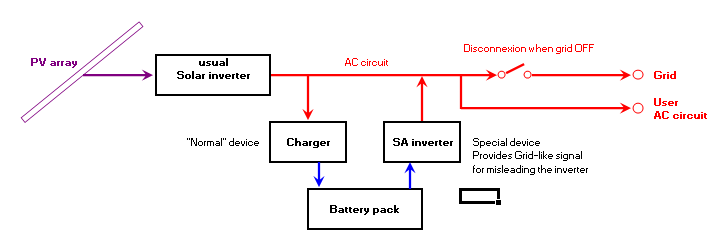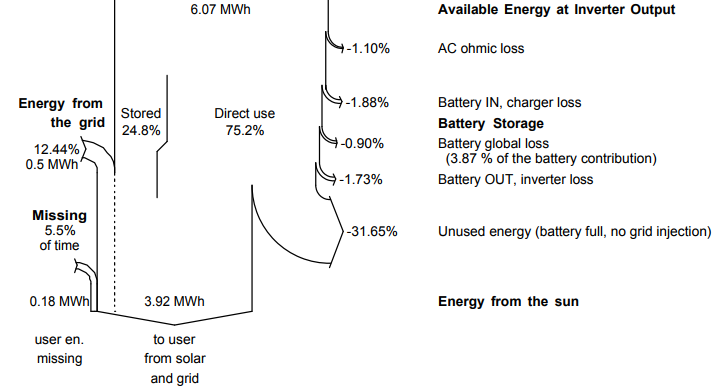Storage: Weak grid, islanding
This option concerns regions where the grid is not reliable (numerous cuts due to load shedding).
The PV energy is stored in a battery, and returned to the user when the grid is OFF. Technologically, this is far from being simple, as the usual solar inverters for feeding the grid require the presence of the grid for working. There may be several ways for avoiding this problem, among them:
- The most simple: considering the internal battery system as a pure stand-alone system with an inverter for battery (Stand-Alone inverter). This will involve a battery charger from the PV system (MPPT => DC converter) and a Grid charger able to feed the battery system from the grid. This configuration doesn't allow to re-inject solar energy into the grid.
- Connecting the grid to the internal AC circuit, and use a standard solar => grid inverter. This requires an advanced technology, with a special Battery inverter (DC input) able to "mimic" the grid for misleading the inverter. When the grid is down, there should be a mechanical switch for physically disconnecting the grid from the installation; in this situation the system will work in islanding mode, the Battery inverter will provide the full power required by the user's consumption. In connected mode, the user's AC circuit is directly connected to the grid.
This allows to inject the solar excess energy into the grid, although this is not always allowed by the grid manager.
Energy flux control
A suited control manages the energy fluxes at each instant.
As for the Self-consumption storage case, there are several operating modes.
- When the sun power is sufficient for feeding the user's needs, the rest is used for charging the battery. If the battery is full the excess will be injected into the grid if this is allowed, otherwise this energy will be lost (i.e. the inverter will operate at reduced energy level).
- When the sun is not sufficient (or during night) the user may be fed by the battery. However we should keep a storage reserve for the case of grid unavailability. Therefore we have to define a limit DOD for using the energy in any case, and another one for supplementing the grid when it is down.
- In case of grid failure, the switch should immediately open, and the user will be fed by the sun's energy + battery through the SA inverter.
- The control device should be able to limit the solar inverter's power if the injection into the grid is not allowed.
Sizing
You have first to define the grid unavailability. This may be done:
- either by specifying the unavailability fraction of time, the number of periods and the minimum / maximum duration of each period. Then the program can propose a random distribution of unavailability periods along the year.
- or define an hourly sequence of unavailability for the whole year in a CSV (msExcel) l file.
The battery pack capacity is closely related to the user's needs. Ideally, the remaining energy below the SOC higher level should allow to cover the maximum needs for the longer unavailability period. You can obviously diminish this capacity, at the risk of feeding failure.
Globally, we can admit that the full battery capacity should cover at least 1 or 2 days of average consumption.
The solar inverter is sized as usually with grid systems.
Simulation and results
Although the system architecture is very different, the simulation process is rather similar to the self-consumption case.
After the simulation, the balances of all the energy fluxes will appear on the loss diagram:
The diagram shows:
| The amount of stored energy (with respect to direct use), which has an impact on the cycling, i.e. the battery lifetime and therefore the cost of the stored energy. | |
| EBatCh - EBatDis | The battery efficiency loss due to the charging/discharging Faradic efficiency, internal resistance, possible gassing (lead-acid) or over-current due to overcharging, etc. |
| CL_Chrg | The operating losses in the charger (inefficiency). |
| CL_InvB | The operating losses in the battery inverter (inefficiency). |
| E_User | the total energy needed by the user (i.e. the specified load profile), which is split into: |
| E_Solar | the user's consumption coming from the sun (here 3.92 MWh) |
| EFrGrid | the missing energy, drawn from the grid when it is available |
| E_Miss | the missing energy, when the grid is not available and the battery is empty. This leads really to a shutdown of the delivery to the user. |
| SolFrac | we name "Solar Fraction" the ratio of the user's energy from solar E_Solar, to the total user's needs (EFrGrid + E_Miss). |
In the mode when the injection into the grid is not allowed:
| EUnused | the excess energy, available from the PV array when the battery is full. |
And when the injection into the grid is possible:
| E_Grid | the excess energy from the PV array when the battery is full and the grid is available. |
| EUnused | the excess energy from the PV array when the battery is full and the grid is not available. |


